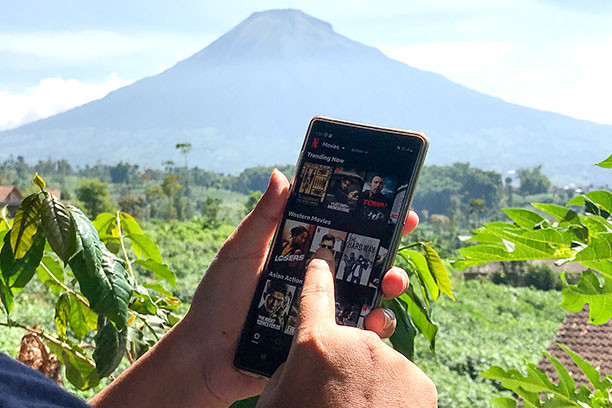How can best regulate video-on-demand industry?
The absence of regulatory requirements for VOD services has tempted traditional broadcasters, such as the MNC Group, to question the balance in the game.
Change text size
Gift Premium Articles
to Anyone

A
udience demand for quality, online content in Indonesia continues to grow and grow, as seen in the increase in viewing hours during the COVID-19 restrictions. By the yearend, it is estimated that nearly 23 million Indonesians will be using video on demand (VOD) services, an increase of nearly 50 percent from 2016!
Despite the demand for online content, running a VOD service is not easy. The sad news of HOOQ’s demise and the recent announcement that iFlix is being sold to Tencent (https://www.scmp.com/tech/apps-social/article/3090594/tencent-snaps-assets-malaysian-streaming-video-service-iflix) at a significant discount illustrate the risks and challenges for players in this entertainment sector.
VOD services need to respond to ever-changing factors, such as finding content that viewers will watch, responding to a dynamic market, evolving consumer behavior and increasing expectations regarding technology. Moreover, according to Asia Video Industry Association (AVIA), 63 percent of Indonesian consumers (https://avia.org/newly-released-survey-finds-63-of-indonesians-have-accessed-streaming-piracy-websites-or-torrent-sites/) are still accessing content through illegal means.
One issue that has been debated for some time is if and how the VOD services industry should be regulated. If the government decides to regulate the industry, should it take a light-handed approach? This has been the case in New Zealand and Japan, where streaming services are able to self-regulate their content with little state intervention. This policy approach has served consumers well and allowed VOD services to flourish.
Currently, only one regulation applies to VOD services. Effective on Aug. 1, 2020, the Finance Ministry imposed value-added tax (VAT) on trade through electronic systems (PMSE), which affects VOD services. Aside from this, no specific regulations or any regulatory body exist for VOD services.
The absence of regulatory requirements for VOD services has tempted traditional broadcasters, such as the MNC Group, to question the balance in the game. Claiming that they are at a disadvantage, broadcasters are actively seeking to level the playing field. On June 21, 2020, RCTI and INEWS TV submitted a petition for judicial review with the Constitutional Court that challenges Law No. 32/2002 on Broadcasting. They are demanding that this law also applies to YouTube and Netflix.
The petition does not have a solid legal basis. The frequency, provision and ecosystem of VOD services are very different from TV broadcasting services. VOD services offer parental control and viewers can “pull” content, unlike conventional broadcasters that “push” content to a wide viewership. Meanwhile, the Broadcasting Law is now almost 20 years old and contains several outdated provisions.
Returning to the original question: Should VOD services be regulated or not? Should they be allowed to offer content to consumers without restrictions? Or should they be regulated the same way as conventional broadcast media?
As mentioned above, viewers today access their screen content very differently from traditional viewers in the days of linear TV. Today’s curated VOD platforms address common concerns about children accessing inappropriate content, a welcome advance compared to TV or user-generated content platforms. “Child locks” are an important tool for parents, and fast-evolving technologies will solve concerns as they arise and more effectively than regulations that could soon become obsolete.
Similarly, VOD services have been developing best practices and trusted methods for self-regulating in line with various government guidelines. Take the content code for VOD providers in ASEAN, under which signatories pledge to be responsible for the content they offer and commit to ensuring consumers are empowered through age verification systems (age gates) or are otherwise able to make informed decisions about the content they and their families watch.
The Indonesian Broadcasting Commission (KPI) and the Film Censorship Institute (LSF) have voiced their wish to regulate the content on streaming services. The two bodies both want VOD providers to adhere to their standards on morality, pornography, violence, drugs and social harmony. However, since VOD services don’t fall under either the Film Law or the Broadcasting Law, neither the KPI nor the LSF have regulatory authority over it.
It’s also worth noting that the KPI and LSF officials are not directly elected. This calls into question whether they should be the ones to set the "moral standards of society" without reference to any clear and specific laws. Or should Indonesian consumers be empowered to make their own, informed decisions?
Ultimately, if the decision is made to regulate the VOD services industry, then let’s make sure that the industry is regulated independently of legacy media, allow for flexibility as technology evolves and agree on a thorough, inclusive approach that is guided by industry best practice and responsible initiatives.
The best solution for regulating digital media content is to launch a digital literacy program that the government initiates in coordination with the industry. The LSF should develop the tools and instruments for the program to provide guidance for parents on age-appropriate viewing. The digital literacy program should be made a part of the national curriculum so that the public is empowered to pick and choose appropriate content according to their individual preferences and sensitivities.
For film producers, VOD services offer a valuable pathway to the global market through licensing and producing original content. Local series like Cek Toko Sebelah and Brata have attracted viewers in competition with foreign productions. HBO Asia produced the period drama Grisse and hired Joko Anwar to make the Indonesian installments of its Folklore and Halfworlds, while Netflix produced The Night Comes For Us and Street Food Asia, and licensed a number of popular local films. VOD services value local productions as essential to attracting local consumers, negating any need for local content quotas.
If the government incentivized rather than penalized the industry, VOD providers will be free to produce many more original Indonesian productions and facilitate business opportunities with producers. By sharing knowledge and best practices, we can advances in terms of not only industry and business growth, but also human resources and screen literacy. This innovative approach will contribute to a healthy and flourishing local digital economy, increased exports of Indonesian stories and augmented soft power across the world.
The VOD industry has what it takes to thrive both domestically and internationally. This is our opportunity to keep any future regulations in check, so we can stimulate this industry and turn it to our advantage.
***
The writer is a producer and advisory board member, the Association of Indonesian Film Producers. The views expressed here are personal.









